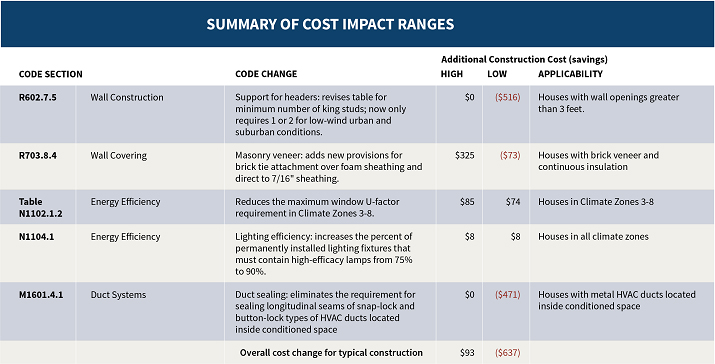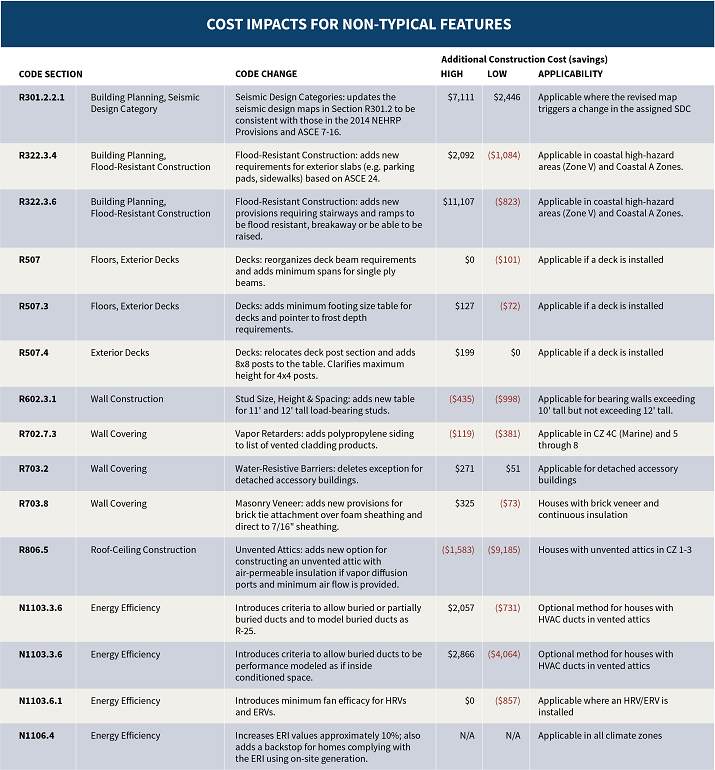2018 I-Codes Adoption Kit
The 2018 I-Codes Adoption Kit consists of three parts:
- Significant changes that were made in the 2018 I-Codes from the 2015 editions: One section for single-family construction and another for multifamily.
- Cost impact of adopting the 2018 IRC to the 2015 edition.
- NAHB-suggested amendments to improve the codes’ practicality and cost effectiveness.
NAHB presented a webinar that discussed significant code changes that home builders can expect. Download the code webinar slide presentation, Significant Change to the 2018 IRC, for details. A summary follows:
Building Planning & Construction Provisions- Section R301.2.2.1, Fig. 301.2(2), Fig. 301.2(3) Determination of Seismic Design Categories. The seismic design maps have been updated to be consistent with those in the 2014 NEHRP Recommended Provisions and ASCE 7-16. The change increases the seismic design category in several areas including New England (particularly New Hampshire), eastern Tennessee, and near Charleston, South Carolina. An alternate map may result in a less stringent category if a geotechnical investigation accurately determines the local soil conditions.
- Section R322.3.4 Flood Resistant Construction – Concrete Slabs. A new provision for Zone V has been added requiring exterior slabs (i.e. parking pads, sidewalks, etc.) adjacent to or under elevated buildings be constructed to break up under flood conditions or be designed to resist flood loads (e.g. erosion and scour). The provisions apply to those slabs likely to cause damage to the building if displaced or undermined by flooding.
- Section R322.3.7 Flood Resistant Construction – Stairways and Ramps. A new provision for Zone V has been added requiring stairways and ramps constructed below the base flood elevation be constructed with open or partially open risers and guards, be designed to break away under flood conditions, or be able to be raised above the flood level. Breakaway stairs are not permitted as part of the primary means of egress.
- Section R507.3 Exterior Deck Footings. A table of minimum footing sizes for deck posts has been added, allowing selection of footing size based on soil-bearing capacity, snow or live load, and area supported by the post.
- Sections R507.4 Exterior Deck Posts. The deck post provisions are revised to require a 4x6 post where the post height exceeds 6' 9” but not 8' 0” and the post supports a 3-ply beam. 8x8 posts are also added to the table, providing an additional option for supporting multi-ply beams.
- Section R703.2 Water-Resistive Barriers. The exception for detached accessory buildings from water-resistive barrier (WRB) requirements is deleted. Some cladding manufacturers require a WRB behind their products even on an accessory structure, which may limit the impact.
- Section R703.8.4, Table R703.8.4(2) Masonry Veneer Anchorage. New provisions and a table are added for brick tie attachment over foam sheathing and direct to 7/16’” wood structural panel sheathing. The provisions and table require ring-shank nails or screws in lieu of 8d common nails and tighter spacing in many cases than traditional 32" horizontal/12" vertical or 16" horizontal/24" vertical tie patterns.
- Section R507.5, Table R507.5 Exterior Deck Beams. The deck beam span table is revised to provide minimum spans for single-ply beams. This will allow a stair landing serving a deck or a porch floor to be supported using single-ply beams instead of 2-ply beams.
- Section R602.3.1, Table R602.3(6) Stud Size, Height and Spacing. A new exception and table are added for 11-foot and 12-foot tall load-bearing studs. The exception and table provide an alternative for great rooms, foyers, garages and other spaces that do not fit the existing option for studs up to 18 or 20 feet.
- Section R602.7.5 Support for Headers. The table for minimum number of king studs supporting headers is revised based on wind speed and exposure category rather than stud spacing. The revised table only requires one or two studs for low-wind urban and suburban conditions.
- Section R702.7.3 Vapor Retarders. Polypropylene siding is added to the list of products which can be considered a vented cladding product under Table R702.7.1. In the applicable climate zones, a builder would be able to omit a Class I or II vapor retarder on the interior side and use latex or enamel paint or other material qualifying as a Class III vapor retarder.
- Section R806.5 Unvented Attics. A new option is added for constructing an unvented attic with air-permeable insulation if vapor diffusion ports and a minimum amount of mechanical ventilation are provided. The option is intended to permit blown fiberglass in netting hung from roof trusses/rafters as an option in warm-humid climate zones.
- Table N1101.1.2 and Table N1101.1.4 Window U-Factor. The maximum window U-factor in Climate Zones 3 and 4 (except 4C) decreases from 0.35 to 0.32. The maximum window U-factor for Climate Zones 4C and 5-8 decreases from 0.32 to 0.30.
- Table N1103.6.1 Fan Efficacy for HRVs/ERVs. A minimum fan efficacy for HRVs/ERVs is introduced. The efficacy is the minimum required by the Energy Star HRV/ERV specification used in Canada. Where an HRV/ERV was classified as an in-line fan (minimum fan efficacy 2.8 CFM/watt), this is a relaxation of the code and a potential savings. Many HRV/ERV models already meet the new requirement, but some models may not, and there can be a cost increase to move to a different model.
- Section N1103.3.6 (R403.3.6) Ducts Buried within Ceiling Insulation. A new provision explicitly allow ducts buried, or partially buried, within ceiling insulation in vented attics (“buried ducts”). The sum of the insulation above and below the duct is at least R-19 total, and the minimum required duct insulation is R-8 except in Climate Zones 1A, 2A, and 3A where it is R-13. If ducts are deeply buried when using the performance path, a duct R-value of 25 can be used in the energy calculation.
- Section N1103.3.7 (R403.3.7) Ducts Located in Conditioned Space. A new provision allows buried ducts to be modeled as being located inside conditioned space where the air handler is located inside conditioned space (not the attic); the duct leakage is within prescribed limits (1.5 CFM25/100SFcfa) and the R-value of insulation above the duct is at least the proposed ceiling insulation R-value, used in the model, less the R-value of the duct insulation.
- Table N1106.4 (R406.4) ERI Values. The tabulated ERI values are increased around 10% and a backstop added for homes complying with the ERI using onsite generation. The revised ERI values bring the ERI compliance closer to the prescriptive path compliance, but still remain about 15% more stringent than one designed using the prescriptive path.
- Section IRC M1601.4.1 Joints, Seams, and Connections. The section was revised to removes the requirement for sealing longitudinal joints on ducts in conditioned spaces. The change will restore the ability to use snap-lock and button button-lock duct joints and seams for ducts located inside conditioned space.
- Appendix T (IECC Appendix RA) Combustion Appliance Zone Testing. Informative Appendix on Combustion Appliance Zone testing for gas appliances, is deleted.
This summary includes changes to the International Building Code (IBC), International Existing Building Code (IEBC), International Energy Conservation Code (IECC), International Fire Code (IFC) and International Mechanical Code (IMC). No significant changes were identified for the International Plumbing Code. This is not all of the changes that were approved. Read the slides on Significant Changes for Multifamily in 2018 and see the summary below.
2018 IBC- Section 406.3 Private Garages and Carports. New language permits a private garage to be constructed using the public parking garage requirements for open and enclosed parking garages. This would allow a garage accessible only to tenants of the building, such as a private garage under a multifamily building, to exceed 1,000 square feet without needing 1-hour separations consisting of 1-hour fire barrier walls with fire doors.
- Section 406.6.2 Ventilation in Enclosed Parking Garages. An exception to providing mechanical ventilation is added for enclosed parking garages that are accessory to one- and two-family dwellings (R-3 buildings). The IRC does not require mechanical ventilation for an attached garage. This change would promote consistency between dwellings constructed as Group R-3 under the IBC versus those constructed under the IRC.
- Sections 423.1, 423.2, and 423.3 Storm Shelters. The design requirements are clarified such that a Risk Category IV classification per Table 1604.5 is only required when the area, rooms or structure are intended for use by the public as a short-term recovery shelter after a hurricane or tornado. For a multifamily building, the effect is that the corridor(s) leading to a storm shelter intended for use solely by the tenants and their guests would not need to be structurally upgraded to Risk Category IV requirements.
- Section 503.1 Height/Area Limits. Clarifies that the building separation created by a fire wall provided in accordance with Section 706 applies only for determining height/area limits and construction type. It does not require all of the elements and systems on each side of the fire wall to be self-contained or self-supporting, except as required by Section 706. Most importantly, the lateral load resistance can be distributed across an entire building, versus an independent system being required for each separated portion.
- Table 602 Fire Resistance Rating. A footnote is added allowing the adjacent exterior walls of Group R-3 buildings to be unrated where the fire separation distance is 5-feet or greater, in lieu of such walls needing to be a one-hour rated wall. This will align the IBC requirements for Group R-3 dwellings with the IRC and permit the affected wall(s) to have no fire rating rather than having to be 1-hour rating.
- Table 705.2 Fire Separation Distance or Projections. The table differs from IBC 2012 by allowing more flexibility to projections in larger buildings and would appear to allow a larger building where projections are desirable.
- Section 706.1.1 Party Walls. A new exception is added specifying that a party wall between buildings does not have to be constructed as a fire wall when the lot line dividing two adjoining properties is solely for ownership purposes and the building heights and areas for the adjoining buildings do not exceed the maximum height and area for the 2018 IBC. For a 4-story townhouse, quadplex, or similar types of buildings, this change would allow for a 1-hour (or even 1/2-hour) fire separation wall between units instead of a 2-hour fire wall.
- Section 1006.3 and 1006.3.1 Egress from Stories or Occupied Roofs. Exceptions are added to allow exiting through more than one adjacent story for R-1, R-2, R-3 dwelling units, sleeping units or live/work units, R-3 Congregate units, and R-4 occupancies. Stairways internal to multi-story dwelling units can now be open as they would in a single-family dwelling.
- Section 1015.3 Guard Height. Exception #1 is modified to remove the vertical measurement used for fixed seating, thus reducing the guard height behind fixed seating by 16-18 inches. For example, where a 54-inch guard is required, a 36-inch guard would now be permitted.
- Section 1030.1 Emergency Escape and Rescue Openings. The requirement for emergency escape and rescue openings in a Group R-2 occupancy is modified to apply only where those occupancies are located in stories with only one exit or access to only one exit per Tables 1006.3.3(1) and (2). The change clarifies that a dwelling unit which has access to two means of egress does not require an Emergency Escape and Rescue opening.
- Section 1604.5.1 Multiple Occupancies. An exception is added clarifying that storm shelters designed per ICC 500 in a building or portion thereof normally occupied for other purposes, the shelter and portions of a building providing access to or egress from the shelter do not have to be classified as Risk Category IV unless the space is intended to be used as a public shelter for short-term recovery after the hurricane or tornado. For a multifamily building, the effect is that the corridor(s) leading to a storm shelter solely intended for use by the tenants and their guests would not need to be structurally upgraded to Risk Category IV requirements.
- Table 1607.1 Live Loads. The live load for Balconies and Decks (item #5) is increased to 1.5 times the live load of the adjoining area served, with a maximum of 100 pounds per square foot (psf). As a result, a deck on a dwelling designed to the IBC would be required to be designed for 60 psf rather than 40 psf as would be required under the IRC.
- Section 1609.1.1, 1609.3 Determination of Wind Loads. The IBC wind provisions are revised to update wind maps to match ASCE 7-16. The new maps reduce wind speeds in the Midwest and West. By reference to ASCE 7-16, new, increased roof component and cladding pressures apply, which may affect roof design (i.e. roof covering, roof decking, and possibly roof trusses).
- Section 1613.2 Seismic Ground Motion Values. The current ground motion maps in the IBC are replaced with new maps from the 2015 NEHRP Recommended Provisions based on a new 2014 USGS update to their seismic ground motion maps. The site coefficient values are also revised, and a minimum value of the site coefficient associated with short-period ground motions is specified where Site Class D soil is chosen as a default. The result may be an increase in the typical Seismic Design Category for many areas unless a detailed geotechnical investigation is performed including an accurate determination of the Site Class.
- Section 2304.12.2.5 Supporting Members for Permeable Floors and Roofs. A new requirement is added that the moisture barrier separating the naturally durable or preservative-treated wood structure from a moisture-permeable floor above (e.g. a concrete or masonry slab) provide for positive drainage of water. In practice, this requires a drainage board or drainage mat be installed between the bottom of the moisture-permeable topping and the waterproofing membrane protecting the framing below.
- Section 2304.12.2.6 Ventilation beneath Balconies or Elevated Walking Surfaces. Requires cross-ventilation of areas of enclosed framing of balconies and elevated walking surfaces. The net free area of ventilation openings must be at least 1/150 of the area of each enclosed area. Where balconies or elevated walking surfaces are required to be fire rated, the provision could require providing that the sprinkler system be extended to the balcony or even require switching to concrete or steel supports rather than wood framing due to a lack of fire-rated assemblies, which allow vents.
- Table 2308.4.1.1(1) and (2), Section 2308.5.5.1 and Figure 2308.5.5.1(1) and (2) Single Member Headers. Provisions are added allowing single-member headers over openings in exterior bearing walls. Header sizes are added to the table of header and girder spans for exterior bearing walls and construction details are provided. Similar provisions appear in the IRC.
- Section 3001.2 Emergency Elevator Communication Systems. A new requirement is added for elevators to include a two-way video and text-based communication system for deaf, hard of hearing, and speech impaired individuals. The requirement applies to all elevators in a building, whether they are accessible to the public (e.g. service elevators) or only serving private dwelling units. No standards are referenced for the design of the system.
- Section 301. 5 Compliance with Accessibility. Allows existing buildings to comply with the 2009 edition of ICC A117.1 instead of the 2014 edition. This will allow upgrading of buildings without requiring interior walls to be relocated to accommodate larger corridor widths and turning distances for motorized scooters.
- Section 305.8.8 Type B Units. Removes the exception for Type ‘I’ and ‘R’ occupancies where the certificate of occupancy was issued for Type B units prior to March 15, 1991 are not required to provide Type B dwelling or sleeping units.
- Table R403.6.1 Fan Efficacy for HRVs/ERVs. A minimum fan efficacy for HRVs/ERVs is introduced. The efficacy is the minimum required by the Energy Star HRV/ERV specification used in Canada. Where a HRV/ERV was classified as an in-line fan (minimum fan efficacy 2.8 CFM/watt), this is a relaxation of the code and a potential savings. Many HRV/ERV models already meet the new requirement, but some models may not, and there be a cost increase to move to a different model.
- Section C405.2.6 Exterior Lighting Controls. A new section for exterior lighting controls that prohibits the use of mechanical exterior time switches for the control of exterior lighting and requires digital lighting controls even on exterior lighting components which are equipped with daylight sensors.
- Section 903.3.1.2.3, [IBC [F] 903.3.1.2.3] Attics. A new section requires a sprinkler system in attics used for living or storage space, or attics in Type III, Type IV or Type V podium buildings if the roof assembly is located more than 55 feet above the lowest level of the fire department vehicle access. For podium buildings, the attic can be constructed with noncombustible materials or fire retardant-treated wood or be filled with noncombustible insulation in lieu of being provided with sprinklers.
- Section 905.3.1 (IBC [F] 905.3.1) Standpipes. A Class III standpipe system is now required to be installed throughout buildings that are four or more stories above or below grade plane.
- Section 3304.5, 3308.1. Fire Watch. The existing provision for a fire watch is strengthened and requirements added for the program superintendent, fire watch personnel, fire watch locations, records, training records, a fire prevention program log, and emergency communications. The authority to require the fire watch remains with the fire code official.
- Section 3308.7.1 Smoke Detectors and Smoke Alarms. A new section is added requiring smoke detectors and smoke alarms to be covered in an area where airborne construction dust is expected or temporarily removed.
- Section 602.1 Plenums. The general language on plenums was revised to clarify that framing cavities can be used as return plenums. The change allows panned framing cavities to be used as return plenums instead of providing mechanical ducts.
- Section 603.9 Joints, Seams and Connections. The section was revised to remove the requirement for sealing longitudinal joints on ducts in conditioned spaces. The change will restore the ability to use snap-lock and button-lock duct joints and seams for ducts located inside conditioned space.
A report on the Estimated Costs of the 2018 IRC Code Changes by Home Innovation Research Labs has determined the cost impact for most homes ranges from a minor $100 increase to a $600 savings over the 2015 International Residential Code. These typical values will vary based on the climate zone and house configuration. See the full 2018 IRC Cost Study.
This is a summary of cost impact ranges for code changes that are expected to affect typical construction in most climate zones.

There are a number of code changes that would not apply to a typical home or location: for example, homes constructed in high seismic design categories, flood zones or homes with decks. The second chart itemizes the cost impact for code changes that affect construction costs for these non-typical features.

Each suggested amendment should be considered individually to ensure that it is an improvement for the jurisdiction. Priorities can differ from region to region, and HBAs should not hesitate to consider alternative code text that may be more appropriate. If there are any questions on the change or the HBA is looking for assistance on modifying the amendment, please contact NAHB staff for assistance.
Suggested amendments to 2018 IRC
Suggested amendments to 2018 IECC
In addition, resources on energy and arc fault interrupters can be found on the Energy Codes page and the Arc-Fault Circuit Interrupters information page.



